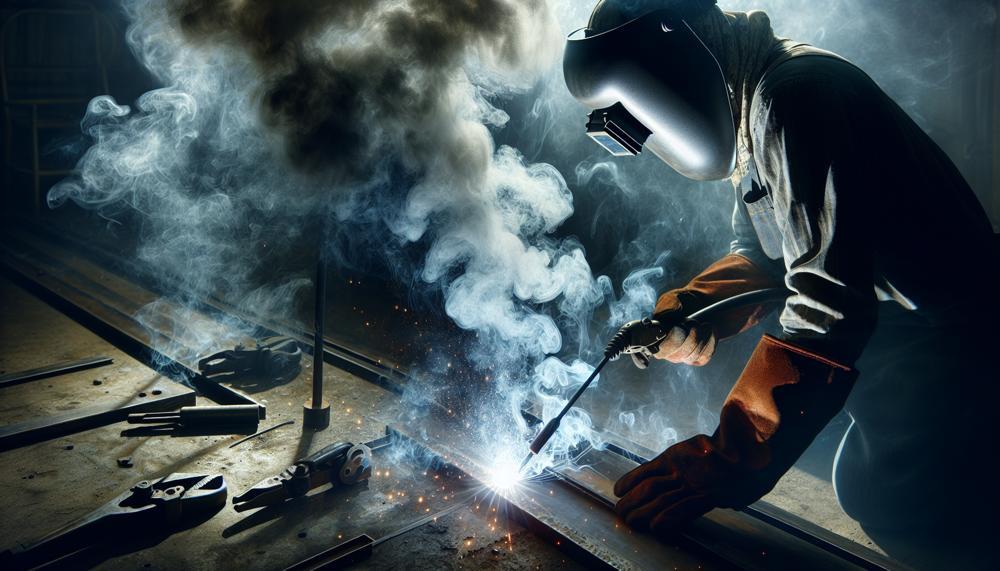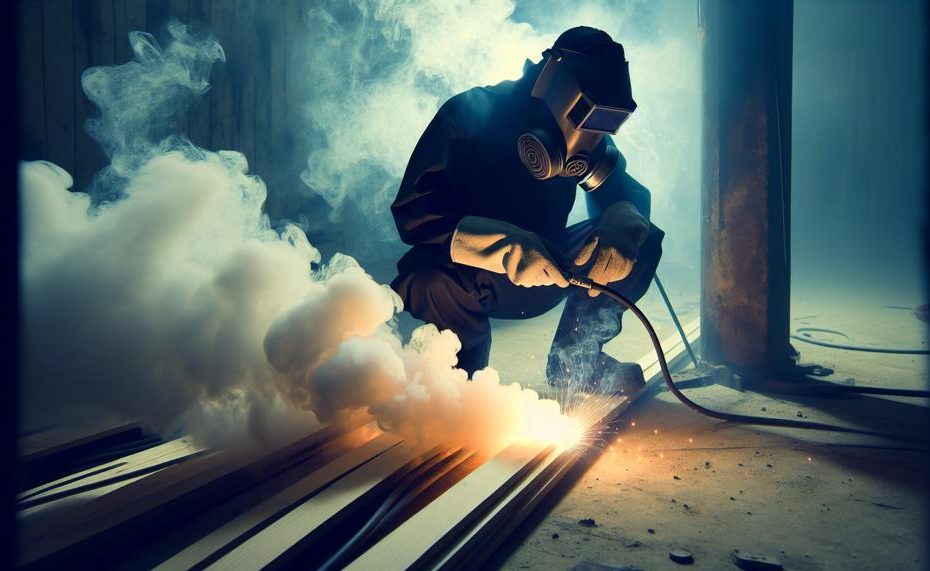Welding is an essential process used in various industries, from construction to manufacturing. It involves joining two or more pieces of metal by melting and fusing them together. While welding is a crucial skill, it can also have negative effects on both the welder and the surrounding environment. These effects are often dependent on the type of metal being welded.
Choosing the right metal for welding is crucial as it can make all the difference in terms of safety and efficiency. Some metals may pose significant health risks and environmental hazards when welded, which should not be taken lightly. As a welder, it’s important to be aware of these potential dangers and take necessary precautions.
So, what metal makes you sick when welding?
Welding processes can produce fumes that are more toxic than those from welding mild steel. These fumes can come from a variety of metals, including:
- Stainless steel
- Cadmium
- Lead-coated steel
- Nickel
- Chrome
- Zinc
- Copper
Inhaling certain metal oxides produced during welding can cause metal fume fever (MFF). MFF is an occupational-related illness that can cause flu-like symptoms, nausea, vomiting, stomach pain, and constipation. MFF can also cause liver damage and brownish discoloration of the eyes. The most common cause of MFF is zinc oxide (ZnO), which is produced from galvanized steel or molten bronze. MFF usually resolves on its own 12–48 hours after exposure, but symptoms can reappear if exposure is repeated. Other metals that can cause MFF include: Copper, Magnesium, Aluminum, Iron. Less common metals that can cause MFF include: Silver, Beryllium, Lead.
So whether you’re a professional welder or work in an industry that involves welding, keep reading to learn more about the harmful effects of welding with certain metals and how you can stay safe while on the job.
Contents
Causes of Metal Fume Fever
The following table illustrates the most prevalent metals that can result in metal fume fever when welding. The table also includes the potential health hazards associated with each metal and how exposure to these metals can occur.
| Metal | Potential Health Hazards | Sources of Exposure |
| Zinc-coated (galvanized) metals and alloys | Respiratory irritation, flu-like symptoms (metal fume fever) | Welding operations involving galvanized metals or alloys |
| Zinc-containing metals and alloys | Respiratory irritation, flu-like symptoms (metal fume fever) | Welding operations involving zinc-containing metals or alloys |
| Copper | Allergic reactions, respiratory issues, lung cancer | Welding operations involving copper or copper-containing materials |
| Iron | Respiratory irritation, lung cancer | Welding operations involving iron or iron-containing materials |
| Aluminum | Pulmonary fibrosis, neurological damage, lung cancer | Welding operations involving aluminum or aluminum-containing materials |
| Tin | Respiratory irritation, coughing, chest pain | Welding operations involving tin or tin-containing materials |
| Chromium, nickel, cadmium, and lead | Allergic reactions, respiratory issues, lung cancer, neurological damage | Welding operations involving these metals or their alloys |
Although these are the most commonly reported causes of metal fume fever in welding, it is vital to note that exposure to other metals like chromium, nickel, cadmium, and lead can also result in this disease. Therefore, welders must take necessary precautions and safeguard themselves from inhaling harmful fumes and gases during welding operations.
When working with these hazardous materials, it is crucial to use proper personal protective equipment (PPE) such as respirators, gloves, and protective clothing. Additionally, ensuring proper ventilation in the workspace and avoiding prolonged exposure to these metals can significantly reduce the risk of developing metal fume fever.
Furthermore, it is essential for welders to undergo regular medical check-ups and educate themselves on the potential health hazards associated with their work.
How to prevent Metal Fume Fever
To prevent metal fume fever while welding, there are several precautions you can take:
Familiarize yourself with the metals that can cause metal fume fever:
- Zinc, copper, and magnesium are known to release harmful fumes when welded.
- These metals are commonly found in welding materials such as galvanized steel, brass, and bronze.
Use appropriate personal protective equipment (PPE):
- Make sure to wear a respirator specifically approved for welding fumes. This will filter out any harmful fumes and protect your lungs.
- Additionally, use gloves and other PPE to safeguard your skin from exposure to these metals.
Ensure proper ventilation:
- It is crucial to have adequate ventilation in your welding work area. This helps reduce the concentration of fumes in the air.
- Consider using exhaust fans or working in an open area with good air circulation.
Take frequent breaks and limit exposure time:
- Taking breaks allows your body to rest and recover from potential exposure to harmful fumes.
- Limiting your exposure time can also help minimize the risk of developing metal fume fever.
Monitor your health:
- Pay attention to any symptoms that may arise, such as headaches or nausea.
- If you experience any signs of metal fume fever, stop welding immediately and seek medical attention.
Always prioritize your health while welding. By following these steps, you can protect yourself from metal fume fever and create a safe working environment.
Symptoms of Metal Fume Fever
| Signs of Metal Fume Fever | How to Detect |
| Fever, chills, body aches, fatigue, and headaches | Appear within a few hours after exposure and can last for up to 48 hours. Similar to symptoms of the flu or respiratory infection. |
| Shortness of breath, chest tightness, and coughing | More severe symptoms that may occur in addition to common symptoms. Can be alarming and require immediate medical attention. |
To detect metal fume fever, it is important to pay close attention to any changes in respiratory health after being exposed to metal fumes. If an individual experiences symptoms like fever, chills, body aches, fatigue, or headaches after working with metals, it could be a clear indication of this condition.
Moreover, if one experiences more serious indications such as shortness of breath, chest tightness, or coughing, it is crucial to seek prompt medical attention. These symptoms may be signs of a severe case of metal fume fever and require proper treatment.
Should I drink milk after welding galvanized?
This belief is a common myth, but there is no scientific evidence to support it. In fact, drinking milk after welding with galvanized metal may even increase the risk of toxic fume poisoning.
| Myth: Milk prevents metal fume fever | Fact: This belief lacks scientific evidence. |
| Milk can increase risk of toxic fume poisoning | The proteins in milk can bind with zinc and other metals, making them easier to be absorbed by the body. |
| Proper precautions should be taken instead | Welders should prioritize using proper personal protective equipment and ventilation to prevent illness and injury while welding. |
It is important for welders to understand the potential hazards of welding, including metal fume fever, and take necessary precautions to protect themselves. This includes wearing appropriate respiratory protection, such as a respirator, and ensuring proper ventilation in the work area.
Does welding shorten your life?
Welding is a profession that can have negative effects on one’s health and potentially shorten their lifespan. Constant exposure to metal fumes containing toxic substances such as chromium, nickel, and manganese can lead to serious health issues like respiratory problems, neurological damage, and even cancer.
To minimize the risks, welders must prioritize safety measures like using appropriate personal protective equipment, proper ventilation, and limiting exposure to galvanized metal fumes through engineering controls and adequate training.
Failure to take these precautions can result in long-term exposure to these harmful metals and significantly affect one’s lifespan.
| Metal | Health Effects | Potential Risks |
| Chromium | Respiratory issues, eye irritation, skin damage | Cancer (lung and nasal) |
| Nickel | Respiratory issues, skin allergies | Cancer (lung, nasal, and throat) |
| Manganese | Neurological problems (manganism), respiratory issues |
In addition to these well-known health risks, long-term exposure to these metals can also lead to other serious health issues like heart disease and kidney damage. These harmful substances have toxic effects on the body’s organs and systems.
It is crucial for welders to be aware of these potential risks and prioritize their safety by taking necessary precautions. Regular medical check-ups and monitoring of exposure levels can also help in early detection of any health issues and taking appropriate measures.
By prioritizing safety and taking necessary precautions, welders can reduce their risk of health issues and potentially prolong their lifespan.
Does welding cause sunburns?
Welding can indeed result in sunburns and pose various health hazards due to prolonged exposure to welding fumes and UV radiation.
The intense heat generated by the welding arc emits UV radiation, which can cause severe sunburns and potential skin damage. Moreover, welding fumes contain toxic substances that can be harmful if inhaled, leading to immediate symptoms and possibly causing long-term health issues.
Extended exposure to UV radiation can also have lasting effects on the eyes and skin, increasing the risk of developing cataracts, premature aging, and even skin cancer. It is vital for welders to take necessary precautions and wear protective gear to minimize their exposure to these risks while working.
Taking these precautions not only protects the welder’s health but also ensures a safe and productive working environment for all.
Should welders wear sunscreen?
The use of sunscreen is highly recommended for welders as it serves as a vital shield against dangerous metal exposure, UV radiation, and burns.
This is particularly important for welders who are constantly exposed to extreme heat and light while working.
The Significance of Sunscreen for Welders
Welding involves the fusion of metal parts using high temperatures, producing intense light and heat from the welding arc. These powerful ultraviolet (UV) rays can cause severe skin damage, including sunburns, premature aging, and even skin cancer.
Furthermore, welders are frequently exposed to harmful metal fumes such as zinc, lead, and cadmium, which can have severe health consequences.
How Sunscreen Works for Welders
Sunscreen creates a physical barrier between the skin and UV rays, preventing them from penetrating the skin. It contains ingredients that either reflect or absorb UV radiation before it can cause any harm.
For welders, it is essential to choose sunscreen with a high sun protection factor (SPF) that can safeguard against both UVA and UVB rays.
Factors to Consider When Selecting Sunscreen for Welders
When selecting sunscreen for welders, there are several factors to consider.
- Firstly, ensure that it offers broad-spectrum protection against both UVA and UVB rays.
- Secondly, opt for physical block sunscreens that contain Zinc Oxide as they provide superior protection against UVC rays.
- Thirdly, go for water-resistant sunscreen as welders often face sweat and water exposure during their work
- Finally, apply sunscreen generously and reapply every two hours or after sweating or swimming.
| Factor | Considerations |
| Broad-spectrum protection | Protects against both UVA and UVB rays |
| Physical block sunscreen | Contains Zinc Oxide for protection against UVC rays |
| Water resistance | Resistant to sweat and water exposure |
| Application | Generously applied and reapplied every two hours or after sweating or swimming |
Advantages of Sunscreen for Welders

There are numerous benefits of using sunscreen for welders.
- Firstly, it can prevent painful and damaging sunburns, reducing the risk of skin cancer.
- Secondly, it offers an additional barrier against harmful metal fumes, providing extra protection for the skin.
- Lastly, it can help minimize the risk of premature aging and other skin damage caused by UV rays.
More Welding Gear Reviews
When it comes to welding gear reviews, the focus should be on the effectiveness and quality of personal protective equipment (PPE) such as helmets, respirators, and protective clothing.
For optimal protection against UV radiation, helmets with auto-darkening lenses are highly recommended. When choosing a respirator, make sure it has proper filters specific to the type of metal being welded and adjustable straps for a comfortable fit.
Protective clothing should cover all exposed skin and be made of durable and heat-resistant material.
It is crucial to have adequate ventilation in the work area to reduce exposure to toxic fumes. This can be achieved through the use of exhaust fans, air filtration systems, and ensuring proper air flow. A table can be used to showcase the different types of PPE and their features for a more comprehensive comparison.
| PPE | Features | Benefits |
| Welding Helmet | – Auto-darkening lenses – Adjustable headgear – Grind mode option |
– Optimal protection against UV radiation – Comfortable fit – Can also be used for grinding |
| Respirator | – Specific filters for different metals – Comfortable fit – Adjustable straps |
– Filters out toxic fumes – Prevents inhalation of harmful particles – Can be customized for a better fit |
| Protective Clothing | – Full coverage of exposed skin – Durable material – Heat-resistant |
– Shields against skin exposure to fumes and heat – Long-lasting – Can withstand high temperatures |
| Ventilation System | – Exhaust fans – Air filtration system – Adequate air flow |
– Removes harmful fumes from the air – Improves air quality in the work area – Reduces exposure to toxic substances |
In addition to considering the features of PPE, it is also important to read reviews from reputable sources and other welders who have used the gear. This can provide valuable insights and first-hand experiences with the effectiveness of the equipment.
Reviews should also mention any potential downsides or limitations of the gear to give a well-rounded perspective.
Also Read: What Do I Need To Be A Coded Welder?
Conclusion
In conclusion, welding is a vital process in various industries, but it can also have detrimental effects on both the welder and the environment. This is particularly true when working with metals such as chromium, lead, zinc, and cadmium, which emit toxic fumes when heated.
These fumes can lead to serious health problems like metal fume fever and even shorten one’s lifespan if proper precautions are not taken.
As a welder, it is crucial to be aware of these potential dangers and prioritize safety measures. This includes using appropriate personal protective equipment and ensuring proper ventilation in the workspace. Regular medical check-ups are also essential for monitoring any health issues that may arise from welding.
While there may be myths about drinking milk after welding with galvanized metal to prevent illness, there is no scientific evidence to support this claim.
Instead, it is important for welders to focus on implementing proper safety measures to protect themselves from harmful fumes.





